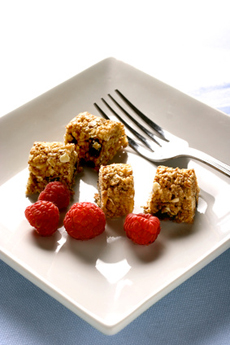

The “deconstructed” bowl of granola (tongue-in-cheek). Photo © Juriah Mosin | Fotolia.
STEPHANIE ZONIS focuses on good foods and the people who produce them.
|
October 2009
|
 |
Granola Bars
Page 1: An Introduction To A “Hot” & Often Wholesome Food
CAPSULE REPORT: When Stephanie Zonis jumps into a topic, it’s a big leap. This is Page 1 of a seven-part article, which includes 20 pages of reviews of specific granola bar brands. If it isn’t “everything you’ve always wanted to know about granola bars,” it’s almost everything! Click on the black links below to visit other other sections.
Article Index
Introduction
Granola bars. Power bars. Nutrition bars. Sports bars. Whole food bars. When did they become so popular and ubiquitous? Scores and scores of artisan brands have proliferated suddenly, resulting in a bewildering variety in natural foods stores and even in grocery store aisles. They’re designed as snacks or post-workout restoratives or even meal replacements, but are any of them worth eating? Not long ago, I decided to find out by conducting a large-scale granola bar taste-test
I don’t typically eat these types of bars. So not only was I unsure of what to expect in tastes, but I was dazzled by the huge number of options on the shelves. In order to cut down on the number of bars I had to sample, I needed to form a broad definition of a granola bar.
- Oats. Because every definition of “granola” I’ve seen indicates that it’s an oat-based product, I wanted any bar I tasted to have oats as one of the first three ingredients. (Read the history of granola.)
- Sweeteners. As I do not consume artificial sweeteners or sugar alcohols such as sorbitol, xylitol and the like, I excluded bars with these ingredients.
- Herbs & Tea—Not. Finally, I didn’t want any bars with herbal or tea extracts, either. This did cut out a good number of products, but I still ended up sampling scores of bars—42 brands and 78 different flavors of bars in all.
Let’s start at the beginning, with the dawn of the granola bar.
History Of The Granola Bar
You can read the history of granola breakfast cereal, which started in a health sanitarium in the late nineteenth century invention. Once very popular, it dropped below the radar for decades, only to reappear with the hippie/health food movement of the 1960s.
But how about the granola bar? Bars made of the cereal did not appear until later, and they’re subject to different claims regarding their invention. Will the real inventor of the granola bar please stand up?
Most sources credit Stanley Mason (photo at right) as the innovator. Mr. Mason was a tireless inventor. He was born in New Jersey in 1921; by the time of his death in 2006, his more than one hundred inventions ranged from the squeezable ketchup bottle to dental floss dispensers. However, this claim is disputed by Herrick Kimball, who claims that he came up with the idea for the granola bar in the mid-1970s. Mr. Kimball’s blog, The Deliberate Agrarian, shows the text of a letter dated July 24th, 1975 that he allegedly sent to an organization called The Idea Marketplace, in addition to an old copy of the first part of that letter.
As one of the claimants to the invention is no longer alive, this matter will likely never be settled. It’s worth noting, though, that the U.S. market for cereal bars of all types, including granola bars, is an exceptionally lucrative one, worth more than $3 billion dollars as of 2005.
|
|

Granola bar inventor Stanley Mason. Photo courtesy MIT. |
Go To Page 2: Health Food Or Health Fad?
Go To The Article Index Above

|





